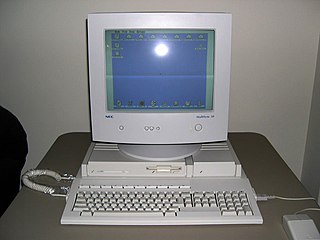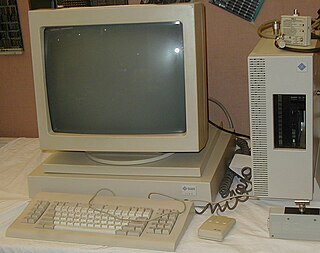
The Motorola 68030 ("sixty-eight-oh-thirty") is a 32-bit microprocessor in the Motorola 68000 family. It was released in 1987. The 68030 was the successor to the Motorola 68020, and was followed by the Motorola 68040. In keeping with general Motorola naming, this CPU is often referred to as the 030.
Mach is a kernel developed at Carnegie Mellon University by Richard Rashid and Avie Tevanian to support operating system research, primarily distributed and parallel computing. Mach is often considered one of the earliest examples of a microkernel. However, not all versions of Mach are microkernels. Mach's derivatives are the basis of the operating system kernel in GNU Hurd and of Apple's XNU kernel used in macOS, iOS, iPadOS, tvOS, and watchOS.

An operating system (OS) is system software that manages computer hardware and software resources, and provides common services for computer programs.
The 88000 is a RISC instruction set architecture developed by Motorola during the 1980s. The MC88100 arrived on the market in 1988, some two years after the competing SPARC and MIPS. Due to the late start and extensive delays releasing the second-generation MC88110, the m88k achieved very limited success outside of the MVME platform and embedded controller environments. When Motorola joined the AIM alliance in 1991 to develop the PowerPC, further development of the 88000 ended.

In computer science, inter-process communication (IPC), also spelled interprocess communication, are the mechanisms provided by an operating system for processes to manage shared data. Typically, applications can use IPC, categorized as clients and servers, where the client requests data and the server responds to client requests. Many applications are both clients and servers, as commonly seen in distributed computing.
Apollo/Domain was a range of workstations developed and produced by Apollo Computer from circa 1980 to 1989. The machines were built around the Motorola 68k family of processors, except for the DN10000, which had from one to four of Apollo's RISC processors, named PRISM.
In computer systems programming, an interrupt handler, also known as an interrupt service routine or ISR, is a special block of code associated with a specific interrupt condition. Interrupt handlers are initiated by hardware interrupts, software interrupt instructions, or software exceptions, and are used for implementing device drivers or transitions between protected modes of operation, such as system calls.
Signals are standardized messages sent to a running program to trigger specific behavior, such as quitting or error handling. They are a limited form of inter-process communication (IPC), typically used in Unix, Unix-like, and other POSIX-compliant operating systems.

A diskless node is a workstation or personal computer without disk drives, which employs network booting to load its operating system from a server.

The Atari TT030 is a member of the Atari ST family, released in 1990. It was originally intended to be a high-end Unix workstation, but Atari took two years to release a port of Unix SVR4 for the TT, which prevented the TT from ever being seriously considered in its intended market.
Accent is an operating system kernel, most notable for being the predecessor to the Mach kernel. Originally developed at Carnegie Mellon University (CMU), Accent was influenced by the Aleph kernel developed at the University of Rochester. Accent improves upon the older kernel, fixing several problems and re-targeting hardware support for networks of workstation machines instead of minicomputers. Accent was part of the SPICE Project at CMU which ran from 1981 to 1985. Development of Accent led directly to the introduction of Mach, used in NeXTSTEP, GNU Hurd, and modern Apple operating systems including Mac OS and iOS.
Spring is a discontinued project in building an experimental microkernel-based object-oriented operating system (OS) developed at Sun Microsystems in the early 1990s. Using technology substantially similar to concepts developed in the Mach kernel, Spring concentrated on providing a richer programming environment supporting multiple inheritance and other features. Spring was also more cleanly separated from the operating systems it would host, divorcing it from its Unix roots and even allowing several OSes to be run at the same time. Development faded out in the mid-1990s, but several ideas and some code from the project was later re-used in the Java programming language libraries and the Solaris operating system.
In computer science, asynchronous I/O is a form of input/output processing that permits other processing to continue before the transmission has finished. A name used for asynchronous I/O in the Windows API is overlapped I/O.
Vanguard is a discontinued experimental microkernel developed at Apple Computer, in the research-oriented Apple Advanced Technology Group (ATG) in the early 1990s. Based on the V-System, Vanguard introduced standardized object identifiers and a unique message chaining system for improved performance. Vanguard was not used in any of Apple's commercial products. Development ended in 1993 when Ross Finlayson, the project's main investigator, left Apple.
The RC 4000 Multiprogramming System is a discontinued operating system developed for the RC 4000 minicomputer in 1969. For clarity, this article mostly uses the term Monitor.

Dataindustrier AB or DIAB was a Swedish computer engineering and manufacturing firm, founded in 1970 by Lars Karlsson and active in the 1970s through 1990s. The company's first product was a board-based computer centered on a specific bus named Data Board 4680. This unit was used for automatic control in several Swedish industries as would be almost all of DIAB's computers. DIAB is mostly known for engineering the ABC 80, the first Swedish home computer, manufactured by Luxor AB.

Sun-3 is a series of UNIX computer workstations and servers produced by Sun Microsystems, launched on September 9, 1985. The Sun-3 series are VMEbus-based systems similar to some of the earlier Sun-2 series, but using the Motorola 68020 microprocessor, in combination with the Motorola 68881 floating-point co-processor and a proprietary Sun MMU. Sun-3 systems were supported in SunOS versions 3.0 to 4.1.1_U1 and also have current support in NetBSD and Linux.

The Sun-2 series of UNIX workstations and servers was launched by Sun Microsystems in November 1983. As the name suggests, the Sun-2 represented the second generation of Sun systems, superseding the original Sun-1 series. The Sun-2 series used a 10 MHz Motorola 68010 microprocessor with a proprietary Sun-2 Memory Management Unit (MMU), which enabled it to be the first Sun architecture to run a full virtual memory UNIX implementation, SunOS 1.0, based on 4.1BSD. Early Sun-2 models were based on the Intel Multibus architecture, with later models using VMEbus, which continued to be used in the successor Sun-3 and Sun-4 families.

Sun-1 was the first generation of UNIX computer workstations and servers produced by Sun Microsystems, launched in May 1982. These were based on a CPU board designed by Andy Bechtolsheim while he was a graduate student at Stanford University and funded by DARPA. The Sun-1 systems ran SunOS 0.9, a port of UniSoft's UniPlus V7 port of Seventh Edition UNIX to the Motorola 68000 microprocessor, with no window system. Affixed to the case of early Sun-1 workstations and servers is a red bas relief emblem with the word SUN spelled using only symbols shaped like the letter U. This is the original Sun logo, rather than the more familiar purple diamond shape used later.
In computer science, the event loop is a programming construct or design pattern that waits for and dispatches events or messages in a program. The event loop works by making a request to some internal or external "event provider", then calls the relevant event handler. The event loop is also sometimes referred to as the message dispatcher, message loop, message pump, or run loop.









